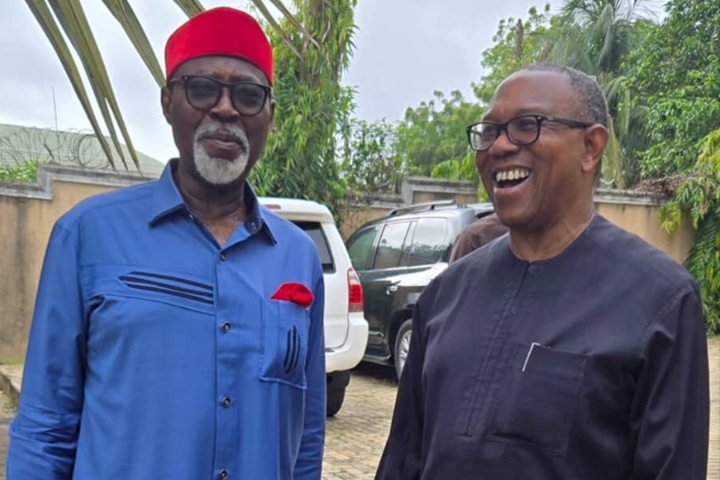The Oba (king) of Benin, Oba Ewuare II, has on Monday, July 15, 2024, received two artefacts, a mother hen and a bronze plaque, from the University of Iowa Museum, United States of America, at his palace in Benin City, Edo State, Nigeria.
Vanguard disclosed this in a report dated July 16, 2024, noting that this is the second time in two months His majesty is receiving returned artefacts.
On May 18, 2024, he received two artefacts from Germany being part of the items looted from the palace during the 1897 invasion of the Benin Kingdom.
What is the 1897 invasion of the Benin Kingdom?
The 1897 Benin Expedition was a British invasion of the Benin Kingdom, which is now part of modern-day Nigeria.
Here are some key points about the invasion:
Key Events:
– February 1897: British forces, led by Admiral Sir Harry Rawson, invade Benin City with a force of 1,200 men.
– The invasion was a response to the killing of a British party, which was sent to negotiate a trade agreement.
– The British captured Benin City, deposed and exiled the Oba, and looted the city, including the palace and other sacred sites.
Aftermath:
– The British annexed the Benin Kingdom and it became part of the British Niger Coast Protectorate.
– The invasion led to the destruction of Benin Kingdom’s independence and its absorption into British colonial Nigeria.
– The looted items, were taken to Britain and other parts of Europe, where many remain in museums to this day.
Oba of Benin, Ewuare II, is known for demanding the return of artefacts looted by the British Empire in 1897 also known as the Benin Bronzes.
In conclusion, he has retrieved several repatriated pieces during his reign.
The artifacts are not just items, they have spiritual implications, mortals cannot understand – The Emperor
Ewuare II, appealed to the political leaders to help preserve the traditions and customs of Benin.
Spiritual implications of the Benin Bronzes
The Benin Bronzes, hold significant spiritual implications for the Edo people and the Benin Kingdom.
Here are some of the spiritual implications:
Connection to ancestors
Benin Bronzes are believed to embody the spirits of the ancestors and are considered a link to the past.
Spiritual power
The artefacts are said to possess spiritual power and energy, which is believed to influence the lives of the Edo people.
Cultural identity
The relics represent the cultural identity and heritage of the Edo people, and their loss is seen as a disruption to their cultural continuity.
Sacred symbols
Many of the artefacts are sacred symbols, such as the Udje Dance Crests, which represent the Edo people’s connection to their gods and goddesses.
Loss of spiritual heritage
Looting of the heirlooms is seen as a loss of spiritual heritage, and their absence is felt deeply by the Edo people.
Disconnection from the divine
Removal of the artefacts is believed to have disconnected the Edo people from their connection to the spiritual realm.
Impoverishment of spiritual landscape
Loss of the artefacts has drained the spiritual landscape of the Benin Kingdom, leaving a void that cannot be filled.
Retrieval of the Benin Bronzes is seen as a way to restore the spiritual balance and harmony of the community.
It is also seen as a means to reconnect the Edo people with their ancestors, cultural identity, and spiritual heritage.
Mr. Cory Gundlach, the Curator, African Art of Stanley Museum, Iowa, apologized to the Oba of Benin.
He apologized on behalf of his other colleagues for using the artifacts as teaching materials in the USA without permission.
Mr. Cory mentioned his determination to ensure that other artifacts looted will be returned to it’s original abode.
The return of Relics
Despite some institutions returning Benin Bronzes, many more remain in Western institutions and the process faces challenges and debates.
Some of the challenges withholding their return include:
Ownership
The main controversy is whether the Benin Bronzes belong to the royal family of Benin or should be under the control of the National Commission for Museums and Monuments (NCMM).
Current location
Many Benin Bronzes remain in Western museums and private collections.
Number
Around 10,000 Benin Bronzes exist worldwide.
Some of the items that are yet to be returned include:
– Carvings
– Statues
– Plaques
– Headpieces
– Silhouettes
– Weaponry
– Tusks
– Many of these items are made of materials other than bronze, despite being referred to as Benin Bronzes
– Some are currently housed in private collections or incorrectly labeled, hence the difficulty in estimating the total number
– Many of the items are sacred and ceremonial objects imbued with a sense of spirituality and cultural importance
– The items were also used by the people of Benin as a way of archiving history.
– Many of the bronzes include depictions of the centuries-old Kingdom of Benin and its civilization
– One of the best known is a bronze head of an Oba.
– Some bronzes are plaques or small statues of lone Portuguese soldiers.
– The Portuguese soldiers are often depicted holding a flintlock pistol surrounded by intricate floral indentations.
– These depictions show a complex relationship between Portugal and the Kingdom of Benin.
Who is Oba of Benin?
The Oba of Benin is the traditional monarch of the Edo people in Benin City, Nigeria. The Oba is the custodian of the rich cultural heritage and traditions of the Benin Kingdom, which dates back to the 13th century.
The current Oba of Benin is Oba Ewuare II, who ascended to the throne in 2016. He is the 40th Oba of Benin and has been working to promote the cultural and economic development of the kingdom.
The Oba of Benin is revered for his:
– Spiritual leadership
– Cultural significance
– Historical importance
– Symbolism of the Benin Kingdom’s rich heritage
– Role in promoting the kingdom’s arts, music, and traditions
The Oba’s palace, known as the Palace of the Oba of Benin, is a UNESCO World Heritage Site and a significant cultural landmark in Nigeria.
For Diaspora Digital Media Updates click on Whatsapp, or Telegram. For eyewitness accounts/ reports/ articles, write to: citizenreports@diasporadigitalmedia.com. Follow us on X (Fomerly Twitter) or Facebook
Post Views: 524












